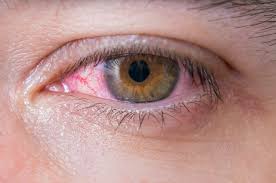Thyroid eye disease (TED), also known as Graves’ ophthalmopathy or Graves’ orbitopathy, is an autoimmune disorder that affects the eyes and occurs in people with Graves’ disease, an autoimmune disorder that causes an overactive thyroid. TED is characterized by inflammation and swelling of the tissues around the eyes, which can lead to a number of symptoms, including:
- Bulging eyes (proptosis): This is the most common symptom of Thyroid eye disease and is caused by the buildup of fluid and fat behind the eyes.
- Double vision (diplopia): This is caused by the inflammation of the eye muscles, which can prevent the eyes from moving together properly.
- Eyelid retraction: This is caused by the swelling of the muscles that control the eyelids, which can make the eyes appear to be staring.
- Light sensitivity (photophobia): This is caused by inflammation of the cornea, the clear front surface of the eye.
- Dry, red eyes: This is caused by inflammation of the conjunctiva, the lining of the eyelids and the front of the eye.
- Pain: This can be caused by inflammation of the muscles around the eyes or by pressure on the optic nerve.
Causes of Thyroid Eye Disease
The exact cause of Thyroid eye disease is unknown, but it is thought to be an autoimmune disorder. In people with TED, the immune system attacks the tissues around the eyes, causing inflammation and swelling. The overactivity of the thyroid gland in Graves’ disease is also thought to play a role in the development of TED.
Risk Factors for Thyroid Eye Disease
The following factors increase the risk of developing TED:
- Being a woman
- Smoking
- Having a family history of TED or Graves’ disease
- Having other autoimmune disorders
Diagnosis of Thyroid Eye Disease
There is no single test to diagnose Thyroid eye disease. Doctors typically diagnose TED based on a combination of medical history, physical examination, and the results of blood tests and imaging tests. Some common diagnostic tests for TED include:
- Blood tests: Blood tests can check for thyroid antibodies, which are proteins produced by the immune system that attack the thyroid gland.
- Eyelid retraction measurement: This test measures the amount of eyelid retraction, which is the distance between the upper eyelid and the iris (the colored part of the eye).
- Hertel exophthalmometry: This test measures the amount of proptosis, or bulging of the eyes.
- Orbital CT scan: This imaging test can show the amount of inflammation and swelling in the tissues around the eyes.
Treatment for Thyroid Eye Disease
There is no cure for Thyroid eye disease, but there are treatments that can help to control the symptoms and prevent complications. Treatment options include:
- Medical treatments: Medications, such as corticosteroids and immunosuppressants, can be used to reduce inflammation.
- Orbital decompression surgery: This surgery is used to create more space in the eye socket, which can relieve pressure on the optic nerve.
- Vision therapy: This therapy can help to improve double vision and other eye movement problems.
- Injections: Hyaluronic acid injections can be used to treat dry eyes.
- Botox injections: Botox injections can be used to treat eyelid retraction.
- Prism glasses: Prism glasses can be used to correct double vision.
Self-care tips for Thyroid Eye Disease
In addition to medical treatment, there are a number of things that people with TED can do to manage their condition at home. These tips include:
- Using artificial tears: Artificial tears can help to relieve dry eyes.
- Wearing sunglasses: Sunglasses can help to protect the eyes from light and wind.
- Sleeping with your head elevated: This can help to reduce swelling in the eyes.
- Avoiding smoking: Smoking can worsen TED symptoms.
- Managing stress: Stress can worsen TED symptoms. Find healthy ways to manage stress, such as yoga or meditation.
Living with Thyroid Eye Disease
Thyroid eye disease can be a challenging condition to live with, but there are a number of things you can do to manage it and live a full and active life. With proper treatment and self-care, you can control your TED symptoms and prevent complications.
Here are some additional tips for living with Thyroid Eye Disease:
- Find a doctor who you trust and who has experience treating TED.
- Work with your doctor to develop a treatment plan that is right for you.
- For more information: fuseinfuison.com





